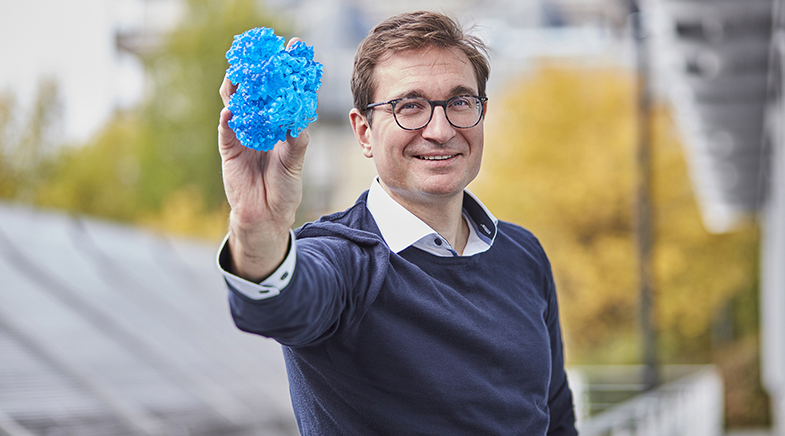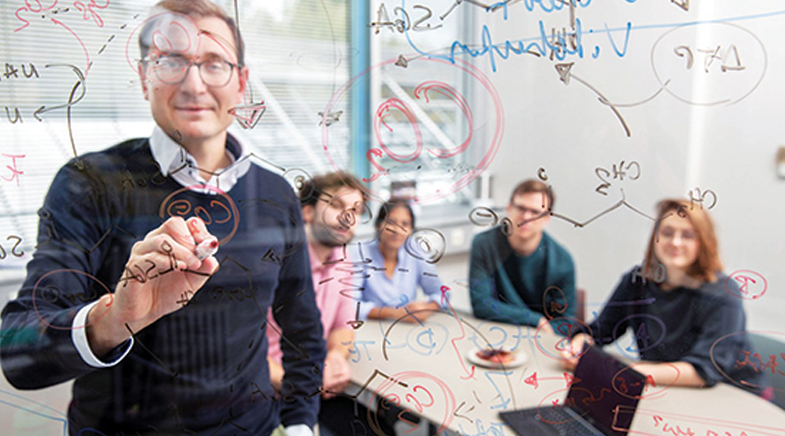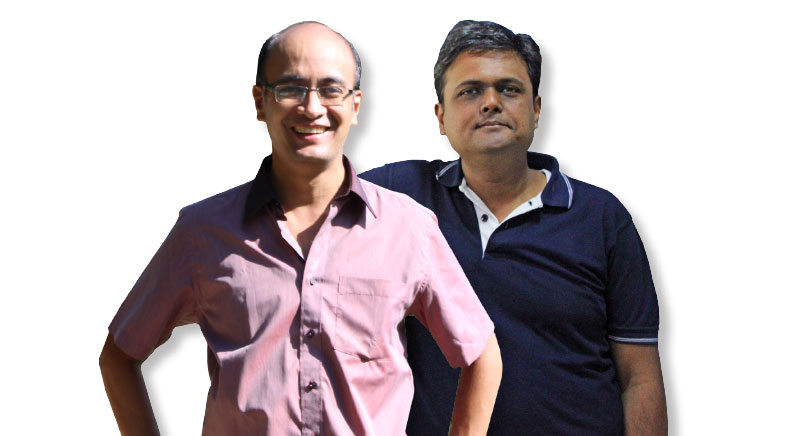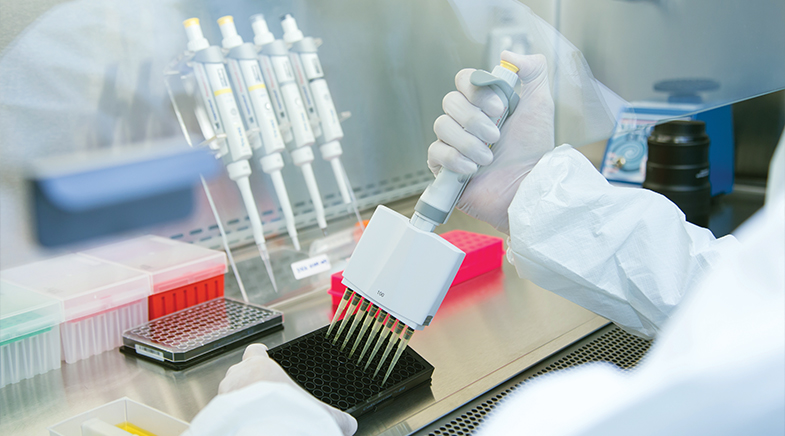'We've neglected biology's capacity to solve problems'
-
- from Shaastra :: vol 01 issue 02 :: Mar - Apr 2022

Dr Tobias Erb on why he believes synthetic biology is a revolutionary technology.
As the Director of the Department of Biochemistry and Synthetic Metabolism at the Max Planck Institute for Terrestrial Microbiology, Marburg, Germany, Dr Tobias Erb explores how natural metabolic pathways function in living cells. In this interview to Manupriya, he expands on his interest in using synthetic biology to capture CO2 from the atmosphere. Excerpts:
Tell us about your lab's work on carbon dioxide fixation.
Our lab is working on understanding the natural basis of carbon dioxide (CO2) fixation. We investigate the tools nature uses to capture CO2. One of the ways is via photosynthesis in plants. But that is not the only way. Bacteria have a lot of enzymes that can capture CO2. We have studied such bacteria to understand the mechanisms and enzymes they use to fix CO2.
We have developed a pathway, a metabolic reaction network, which can fix CO2 faster and more efficiently than natural photosynthesis. We call this pathway the CETCH cycle. As in natural photosynthesis, we need chemical energy to run the CETCH cycle. Taking help from nature, we built artificial chloroplast-like structures that can convert light into chemical energy and power our carbon fixation pathway.
How different is the CO2 fixation pathway developed in your lab from the one that exists in nature?
To make any synthetic pathway, we need natural building blocks. In our pathway, these blocks are derived from bacteria, human beings and plants. We pick the best parts and design the rest of the components ourselves.
We look at many different organisms to find areas that may have been overlooked during the course of evolution. Evolution works by building on things that exist. It refines and adds on features to an already existing principle. We, on the contrary, don't mind inventing a newer, better way of doing things. It is a bit like… there is a mobile phone and then there is a new updated version, and again another updated version. And, suddenly, someone brings out a smartphone with a touchscreen. This opens up entirely new possibilities. Similarly, what we have built is inspired by nature but engineered from an entirely new combination of natural and synthetic parts, and it is supposed to be faster and more efficient than natural CO2 fixation.

And how much faster would that be?
In plants, the limiting factor in CO2 fixation is the rate of CO2 uptake in photosynthesis. This is because the enzyme driving this process, rubisco, is very slow. It typically fixes only 5-10 molecules per second. There are other enzymes in nature that can fix CO2 at a much faster rate, but plants are stuck with rubisco. We found an enzyme that is almost 20 times faster than rubisco. It is called ECR (enoyl-CoA carboxylase/reductase) and is found in bacteria. We had stumbled onto this enzyme more than a decade ago while studying some microorganisms. When we discovered this enzyme, we thought, 'oh, wow, that's such a cool solution to overcome rubisco's limitation.'
The ECR enzyme operates in acetic acid assimilation. It looks like this enzyme came into existence very late in the evolutionary timeline. By the time it made an appearance, CO2 fixation and photosynthesis were already established in nature. Even though it basically could have been a competitor to rubisco, this couldn't happen. It's a bit like being a new start-up with a cool idea but not being able to do much because the market is already saturated with an established player.
"We're looking to move the CO2 fixation system that we built in our lab into a living organism. If we can replace natural photosynthesis with this solution, it will be exciting."
What else are you working on?
Apart from building these systems that can capture CO2 efficiently, we are also interested in making value-added compounds, using bits and portions of this pathway. With our CETCH cycle, you can take CO2 directly and convert it to a variety of compounds in less time and more sustainably than in typical chemical factories. For instance, we have demonstrated the production of terpenes and polyketides from CO2.
We are also interested in moving the CO2 fixation system that we have built in our lab into a living organism. To use an analogy, we have built the software and are trying to put it into the hardware. It will take many iterations to get it right. It's not straightforward, it's a big challenge, a big vision. But I am hopeful. If we can really replace natural photosynthesis with this new solution, it will be super exciting.
Will you grow bacteria with CETCH in large bioreactors that will harvest CO2 from the atmosphere?
If we succeed in transferring the CETCH cycle to actual plants, we can harvest 20% more CO2 from the atmosphere. All the extra CO2 fixed by the plants will also increase the yields.
We are also thinking about solutions where instead of changing the entire photosynthetic pathway, we make small changes in the existing mechanism. You would keep photosynthesis as it is, but add parts that help it become more efficient. We have already been able to do this with some plants, giving their photosynthetic machinery a boost.
"Sustainability, food security and health are big global problems right now and synthetic biology can provide solutions for all of them."
How did you get interested in synthetic biology and rubisco?
I was always interested in the interface of chemistry and biology. The cool thing about chemistry is that you try to understand molecules or atoms, how they are put together, and then use this knowledge to make new molecules and materials. Whereas in biology, we have typically been looking at things purely analytically: this is a tree, how does it work? But we have not thought further about building a tree or building new photosynthesis. That's something else, right? I think it's my training in chemistry, this process of taking what you observe and trying to build a modified version, which shaped my approach to synthetic biology.
It's also a natural evolution for any science, to go from the descriptive part to the synthetic part. You have this in physics, from natural laws to engineering; in chemistry, from classical chemistry to organic synthetic chemistry; and now in biology, from classical descriptive biology to synthetic biology. I think my early training and the zeitgeist came together to nudge me towards synthetic biology.
As far as rubisco and photosynthesis are concerned, I have always been concerned about sustainability. And now, with my work, I am positioned to hopefully contribute towards a solution.
What about the risks associated with synthetic biology?
There are risks, but there are benefits, too. We need to discuss both aspects, and as a scientist I can help guide these discussions. Think about AI: it's being used to drive cars, predict the course of stock markets and so much more. It is dangerous, but we still use it and try to mitigate the risks. We have to develop a balanced view on any emerging technology...
I think synthetic biology is a revolutionary technology. Biology has the answers to many problems. We have neglected the power of biology to solve problems on a global scale. Sustainability, food security and health are big global problems right now, and I think synthetic biology can provide solutions for all of them.
Have a
story idea?
Tell us.
Do you have a recent research paper or an idea for a science/technology-themed article that you'd like to tell us about?
GET IN TOUCH














